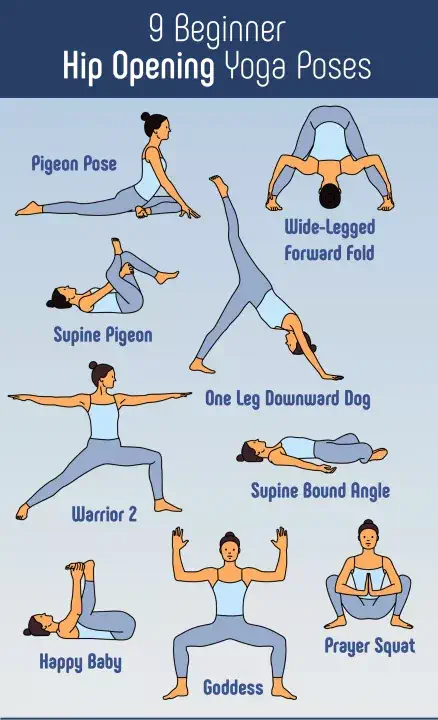9 Beginner-Friendly Hip Opening Yoga Poses to Increase Mobility and Relieve Tension
Are you looking to enhance flexibility, reduce lower back discomfort, and ease tight hip muscles? Hip opening yoga poses are an excellent way to address stiffness, improve posture, and create more space in your pelvic region. Whether you’re brand new to yoga or a seasoned practitioner revisiting the basics, incorporating beginner-friendly hip openers can be a transformative experience for your body and mind. In this comprehensive guide, we’ll explore nine beginner yoga poses that focus on opening up your hips. We’ll also discuss the benefits of each pose, how to do them safely, and essential tips for getting the most out of your practice.
Table of Contents
- Why Focus on Hip Opening?
- Important Safety Considerations
- Pose 1: Pigeon Pose (Eka Pada Rajakapotasana)
- Pose 2: Wide-Legged Forward Fold (Prasarita Padottanasana)
- Pose 3: Supine Pigeon (Modified Figure Four Stretch)
- Pose 4: One-Leg Downward Dog (Tri-Pod Dog)
- Pose 5: Warrior II (Virabhadrasana II)
- Pose 6: Supine Bound Angle (Supta Baddha Konasana)
- Pose 7: Happy Baby (Ananda Balasana)
- Pose 8: Goddess Pose (Utkata Konasana)
- Pose 9: Prayer Squat (Malasana)
- Tips for a Safe Hip-Opening Practice
- Frequently Asked Questions (FAQs)
- Conclusion
1. Why Focus on Hip Opening?
The hips are a complex network of muscles, ligaments, and joints that bear much of the responsibility for everyday movement—like walking, standing, and sitting. If you lead a largely sedentary lifestyle (or spend a lot of time sitting at a desk), these muscles can become tight and restricted. Over time, tight hips can contribute to discomfort in the lower back, limited mobility, and even poor posture.
Key benefits of hip opening poses include:
- Improved Flexibility: Stretching and releasing tension in the muscles around your hips—such as the hip flexors, glutes, and adductors—can help you move more freely.
- Reduced Discomfort: Tight hips often contribute to aches in the lower back and knees. Alleviating hip tension may ease these related pains.
- Better Circulation: When muscles and connective tissues are less restricted, blood flows more easily, supporting overall vitality.
- Enhanced Athletic Performance: Maintaining supple hips can improve your range of motion and stability, which benefits activities like running, dancing, or cycling.
- Mind-Body Connection: Yoga encourages you to slow down and become aware of your body, helping reduce stress and promote relaxation.
2. Important Safety Considerations
Before we dive into the specific poses, it’s vital to understand a few safety guidelines:
- Warm-Up: Spend at least five to ten minutes warming up, focusing on gentle stretching or low-intensity movement. This could involve a few rounds of Cat-Cow Pose, a short walk, or light cycling to get blood flowing.
- Listen to Your Body: Pay attention to how each pose feels. If you experience any sharp pain, numbness, or pinching sensations, ease out of the pose.
- Breathe: Steady, controlled breathing helps you relax and sustain deeper stretches. Resist the urge to hold your breath while in a pose.
- Use Props: Yoga blocks, bolsters, cushions, or blankets can be excellent tools for making these poses more accessible.
- Consult a Professional: If you’re unsure about any pose or have a preexisting condition, consult a healthcare provider or a qualified yoga instructor before attempting new exercises.
3. Pose 1: Pigeon Pose (Eka Pada Rajakapotasana)
Overview:
Pigeon Pose is a classic hip opener known for targeting the hip flexors, glutes, and lower back. It can help release tension from prolonged sitting or intense workouts.
How to Do It:
- Begin in a tabletop position or transition from Downward-Facing Dog.
- Bring your right knee forward, placing it behind your right wrist, and extend your left leg straight behind you.
- Flex your right foot slightly to protect the knee joint.
- Square your hips toward the front of your mat and lower your torso over your bent leg, resting on your forearms or hands.
- Hold for 5–10 breaths, then switch sides.
Modifications & Tips:
- Place a folded blanket or block under your seated hip for extra support.
- Keep your upper body lifted if lowering to the ground causes discomfort in the hips or knees.
Benefits:
- Deeply stretches the hip flexors and piriformis muscle.
- Can help alleviate lower back tension.
- Encourages better posture by opening the chest if you remain upright.
4. Pose 2: Wide-Legged Forward Fold (Prasarita Padottanasana)
Overview:
Wide-Legged Forward Fold targets the inner thigh muscles (adductors) and hamstrings, aiding in hip flexibility. It also gently elongates the spine.
How to Do It:
- Stand with your feet wider than hip-distance apart. Turn your toes slightly inward.
- Place your hands on your hips, inhale to lengthen your spine, and exhale as you hinge forward from the hips.
- Bring your hands to the floor or onto blocks for support.
- Keep your spine long and avoid rounding your back excessively.
- Hold for 5–8 slow, deep breaths.
Modifications & Tips:
- Bend your knees slightly if your hamstrings or lower back feel too tight.
- Experiment with hand placement, such as resting on blocks or placing hands on ankles.
- Engage your abdominal muscles to protect your lower back.
Benefits:
- Stretches the hamstrings, calves, and lower back.
- Improves hip and inner thigh mobility.
- Helps with balance and grounding.
5. Pose 3: Supine Pigeon (Modified Figure Four Stretch)
Overview:
Supine Pigeon, often called “Reclined Figure Four,” is a gentler alternative to Pigeon Pose. It’s ideal for beginners or those with knee sensitivities.
How to Do It:
- Lie on your back with knees bent and feet flat on the floor.
- Cross your right ankle over your left thigh, just above the knee.
- Thread your hands behind your left thigh or over the shin if you’re more flexible.
- Gently pull your left leg toward your chest while keeping your shoulders grounded.
- Hold for several breaths, then switch legs.
Modifications & Tips:
- If you can’t comfortably reach your thigh, use a strap or towel.
- Keep both feet flexed to protect your knee joints.
Benefits:
- Opens the glutes and outer hips.
- Safe for those with knee issues compared to traditional Pigeon Pose.
- Helps improve lower body flexibility and relieves tension in the lumbar area.
6. Pose 4: One-Leg Downward Dog (Tri-Pod Dog)
Overview:
A variation of the classic Downward-Facing Dog, One-Leg Downward Dog targets the hamstrings, calves, and helps open the hips by lifting one leg.
How to Do It:
- Begin in Downward-Facing Dog with your hands shoulder-width apart and feet hip-distance apart.
- Lift your right leg toward the ceiling, keeping your hips square initially.
- To open the hip, bend the lifted knee and allow your right hip to stack on top of the left. Keep your shoulders square.
- Breathe here for several cycles, then switch sides.
Modifications & Tips:
- Slightly bend the standing leg if your hamstrings are very tight.
- Move slowly and mindfully to avoid collapsing into your shoulders.
Benefits:
- Builds upper-body strength and stability.
- Stretches the hip flexors and hamstrings.
- Encourages coordination and balance.
7. Pose 5: Warrior II (Virabhadrasana II)
Overview:
Warrior II is a foundational standing pose that activates the hips, thighs, and core. It’s also beneficial for building stamina and improving posture.
How to Do It:
- Stand at the front of your mat and step your left foot back about 3–4 feet.
- Turn your left foot out at a 90-degree angle and align your heels.
- Bend your right knee directly over the ankle, aiming for a 90-degree bend.
- Extend both arms out to the sides at shoulder height, palms facing down.
- Gaze softly over your right hand and hold for 5–10 breaths. Then switch sides.
Modifications & Tips:
- Shorten your stance if you feel unstable.
- Keep your torso upright and shoulders relaxed.
- Engage your core to support the lower back.
Benefits:
- Strengthens and opens the hips and groin.
- Builds endurance in the legs and core.
- Promotes a sense of grounding and focus.
8. Pose 6: Supine Bound Angle (Supta Baddha Konasana)
Overview:
Supine Bound Angle is a restorative pose that gently opens the hips and inner thighs while you lie on your back, making it excellent for relaxation.
How to Do It:
- Lie on your back with knees bent.
- Bring the soles of your feet together, allowing your knees to fall outward.
- Rest your arms alongside your body, palms facing up or on your belly.
- Use pillows, blocks, or folded blankets under your knees if needed.
- Breathe deeply for as long as comfortable.
Modifications & Tips:
- For deeper relaxation, place a bolster along your spine or under your back.
- Keep your chin slightly tucked to maintain a neutral neck position.
Benefits:
- Stretches the groin and inner thigh muscles.
- Calms the nervous system when combined with mindful breathing.
- Helps relieve tension and stress after a long day.
9. Pose 7: Happy Baby (Ananda Balasana)
Overview:
Happy Baby Pose is a playful, gentle posture that targets the inner thighs, hamstrings, and lower back. It also lightly massages the spine.
How to Do It:
- Lie on your back and draw your knees toward your chest.
- Grab the outer edges of your feet or wrap your hands around your big toes.
- Gently open your knees wider than your torso, bringing them closer to your armpits.
- Keep your tailbone on the mat if possible, or use slight rocking motions side to side.
- Hold for at least 5–10 full breaths.
Modifications & Tips:
- If holding your feet is challenging, hold your ankles or use a strap around your feet.
- Keep your neck relaxed and shoulders on the ground.
Benefits:
- Stretches the inner groin and spine.
- Encourages relaxation and releases tension in the sacrum.
- Improves overall hip mobility.
10. Pose 8: Goddess Pose (Utkata Konasana)
Overview:
Goddess Pose, or Fierce Angle Pose, is a powerful standing posture that targets the hips, thighs, and core. This pose builds strength and confidence.
How to Do It:
- Begin by standing with feet wide apart, toes turned out about 45 degrees.
- Bend your knees and lower your hips toward the floor, aligning your knees over your ankles if possible.
- Bring your hands to heart center or stretch your arms out to shoulder height.
- Maintain an upright torso and engage your core to protect the lower back.
- Hold for 5–8 breaths, feeling the heat build in your thighs and glutes.
Modifications & Tips:
- Place your hands on your hips for more stability if balancing is challenging.
- Don’t force a deep squat; gradually work on opening the hips.
Benefits:
- Strengthens the lower body, including quads, glutes, and inner thighs.
- Increases hip flexibility.
- Builds stamina and mental resolve.
11. Pose 9: Prayer Squat (Malasana)
Overview:
Prayer Squat, or Malasana, is a deep squat that’s excellent for stretching the ankles, groin, and lower back, making it a staple hip opener in yoga sequences.
How to Do It:
- Stand with feet slightly wider than hip-distance apart, toes angled outward.
- Bend your knees and lower your hips into a deep squat, bringing your palms together at heart center.
- Use your elbows to gently press your knees outward if comfortable.
- Keep your spine tall and your gaze forward.
- Stay for 5–7 breaths, then slowly rise, pressing into your feet.
Modifications & Tips:
- Place a block or cushion under your seat if you cannot lower your hips all the way.
- Keep your heels on the ground if possible. If your heels lift, put a folded blanket under them.
Benefits:
- Opens the hips, groin, and lower back.
- Strengthens the ankles and core.
- Helps improve balance and posture over time.
12. Tips for a Safe Hip-Opening Practice
- Move Slowly: Especially as a beginner, take your time entering and exiting poses to avoid strain or injury.
- Warm-Up: A dynamic warm-up (like a few rounds of Sun Salutations) prepares your muscles and joints for deeper stretches.
- Use Breath: Inhale to lengthen or prepare, exhale to deepen into the pose. This synchronicity helps protect your muscles and prevents sudden jerks.
- Mindful Alignment: Ensure your knees, ankles, and hips are aligned properly. For example, in lunges or squats, keep your knee directly over your ankle.
- Consistency: Practice regularly for the best results. Even a few minutes of hip-opening stretches daily can gradually increase mobility.
13. Frequently Asked Questions (FAQs)
Q1: How often should I practice hip-opening yoga poses?
A: Consistency is key. Aim for at least 2–3 times a week to see noticeable improvements in flexibility and comfort. However, daily short sessions can also be highly beneficial.
Q2: Do I need any special equipment?
A: While a yoga mat, blocks, and straps are helpful, they are not strictly necessary. You can improvise with cushions or towels if you don’t have yoga props.
Q3: Can these poses help relieve lower back pain?
A: Many forms of lower back pain stem from tight hips. Releasing tension in the hip flexors and glutes can relieve strain on the lumbar region. However, consult a medical professional for personalized advice if pain persists.
Q4: Is it normal to feel discomfort in my knees during hip openers?
A: It can happen if your hips are very tight or your alignment is off. Always adjust the pose, use props, or shorten the depth of the stretch to avoid knee pain.
Q5: Can I practice hip-openers if I have a previous hip or knee injury?
A: It’s best to consult a healthcare provider or a certified yoga therapist before practicing, especially if you have an existing condition. Modifications might be necessary for safety.
Q6: Should I do hip-opening poses before or after a workout?
A: There’s no strict rule, but many people enjoy hip openers after a workout when muscles are warm. This can help alleviate post-exercise stiffness.
14. Conclusion
Hip-opening yoga poses offer a wide range of benefits, from easing lower back pain and improving posture to enhancing overall flexibility and mobility. These nine beginner-friendly poses—Pigeon, Wide-Legged Forward Fold, Supine Pigeon, One-Leg Downward Dog, Warrior II, Supine Bound Angle, Happy Baby, Goddess Pose, and Prayer Squat—are excellent additions to any yoga or fitness routine. By moving mindfully, using the breath, and respecting your body’s unique anatomy, you can gently unlock tension held in your hips and experience greater comfort both on and off the mat.
Remember: Yoga is a journey, not a race. Progress may be gradual, but with consistent practice, you’ll notice tangible improvements in your flexibility, balance, and overall well-being. Stay patient, listen to your body, and always prioritize safe alignment to enjoy a sustainable and rewarding hip-opening practice.
If you found this guide helpful, feel free to share it with others who might benefit. And don’t forget to explore additional yoga resources for more in-depth practices, tips, and modifications. Happy stretching!
Disclaimer: Always consult a healthcare professional or a certified yoga instructor before beginning any new exercise routine, especially if you have preexisting health concerns. The information provided in this article is for educational purposes and does not replace professional medical advice.










